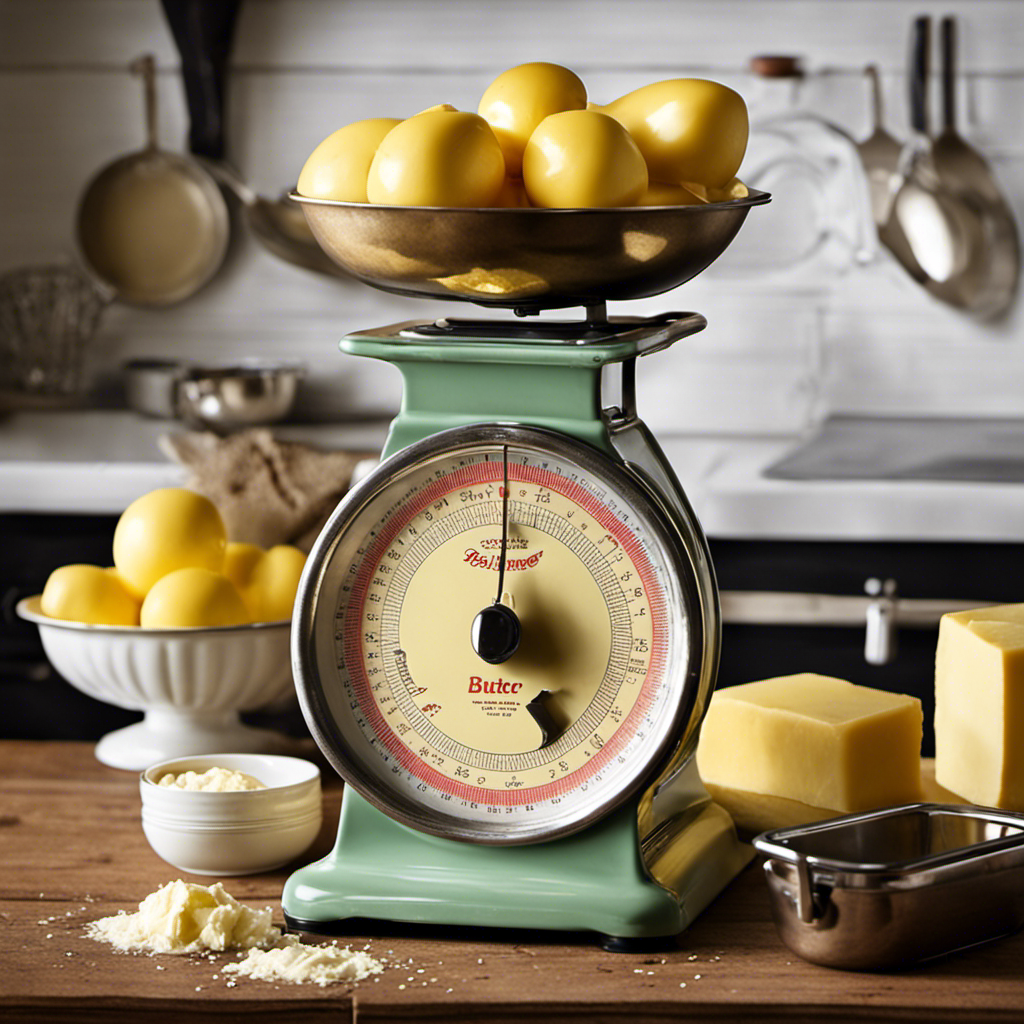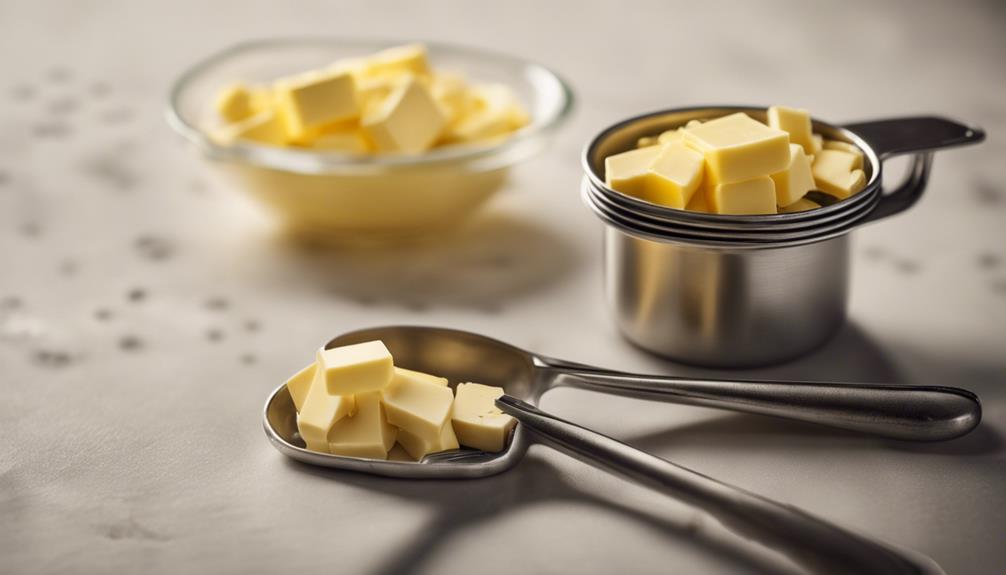Truffle butter elevates your dishes with its creamy texture and rich flavor. To make it, soften high-quality unsalted butter, then finely chop fresh truffles and blend them in. A good ratio is one ounce of truffles per half cup of butter, seasoned lightly with salt. You can use truffle butter in various ways: melt it over steak, mix it into risotto, or stir it into mashed potatoes for an extra touch of luxury. Pair it with mushrooms or aged Parmesan for enhanced taste. You'll discover even more delicious combinations and serving ideas ahead.
Key Takeaways
- Truffle butter is made by blending softened unsalted butter with finely chopped truffles, truffle oil, and a pinch of sea salt.
- Fresh truffles should be firm and aromatic; larger truffles typically offer more intense flavor.
- Use truffle butter to enhance dishes like pasta, risotto, and roasted vegetables for a gourmet touch.
- Store truffle butter in airtight containers in the refrigerator, or freeze for longer shelf life.
- Pair truffle butter with ingredients like aged Parmesan, seafood, and mushrooms to elevate flavors.
What Is Truffle Butter?
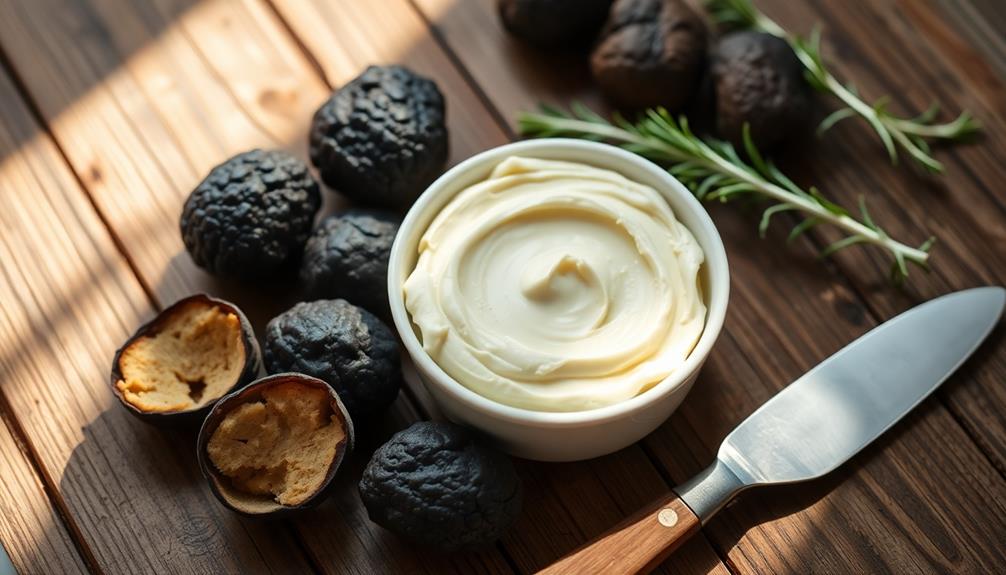
Truffle butter is a luxurious compound made by blending softened butter with finely chopped truffles, often mixed with a touch of salt and other seasonings. This rich spread captures the earthy, aromatic essence of truffles, elevating any dish it graces. You can think of truffle butter as a culinary secret weapon, adding depth and sophistication to your meals.
When you use truffle butter, it's perfect for finishing dishes like pasta, risotto, or grilled meats. Just a dollop can transform a simple plate into a gourmet experience. Its creamy texture melds beautifully with hot foods, allowing the flavors to blend seamlessly.
You'll also find it pairs wonderfully with vegetables, enhancing their natural flavors without overpowering them.
Storing truffle butter is easy. Just wrap it tightly in parchment paper or transfer it to an airtight container. Keep it in the fridge, and it'll last several weeks. If you want to savor truffle butter longer, you might even consider freezing it.
Whether you're a seasoned chef or a home cook, incorporating truffle butter into your repertoire can inspire creativity and elevate your culinary creations. Enjoy the luxurious touch it brings to your kitchen!
Ingredients Needed
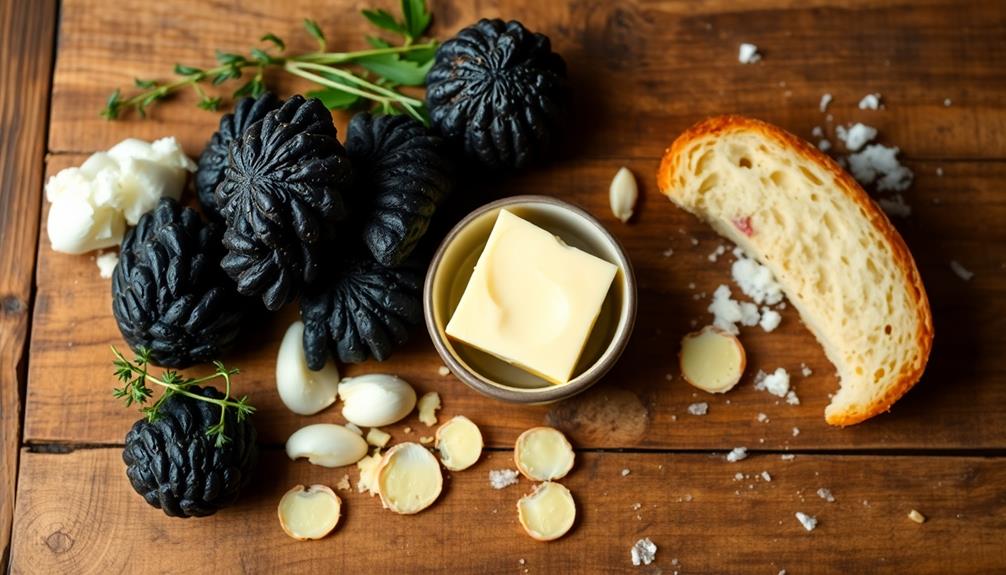
To make your own truffle butter, you'll need just a few simple ingredients. This rich and decadent spread can elevate any dish, and gathering the right components is key to achieving that luxurious flavor.
Here's what you'll need:
- Unsalted Butter: Start with high-quality unsalted butter. It acts as the base for your truffle butter and allows the truffle flavor to shine through without any added saltiness.
- Truffle Oil: Look for a good quality truffle oil, preferably made with real truffles. This will infuse your butter with that distinct earthy aroma and flavor.
- Fresh Truffles (optional): If you want to go all out, consider adding finely grated fresh truffles. They'll enhance the truffle taste and give your butter an even richer profile.
- Sea Salt: A pinch of sea salt will help balance the flavors, bringing out the richness of the butter and the earthiness of the truffles.
Once you gather these ingredients, you're well on your way to creating a gourmet treat that can elevate your culinary creations!
Making Truffle Butter
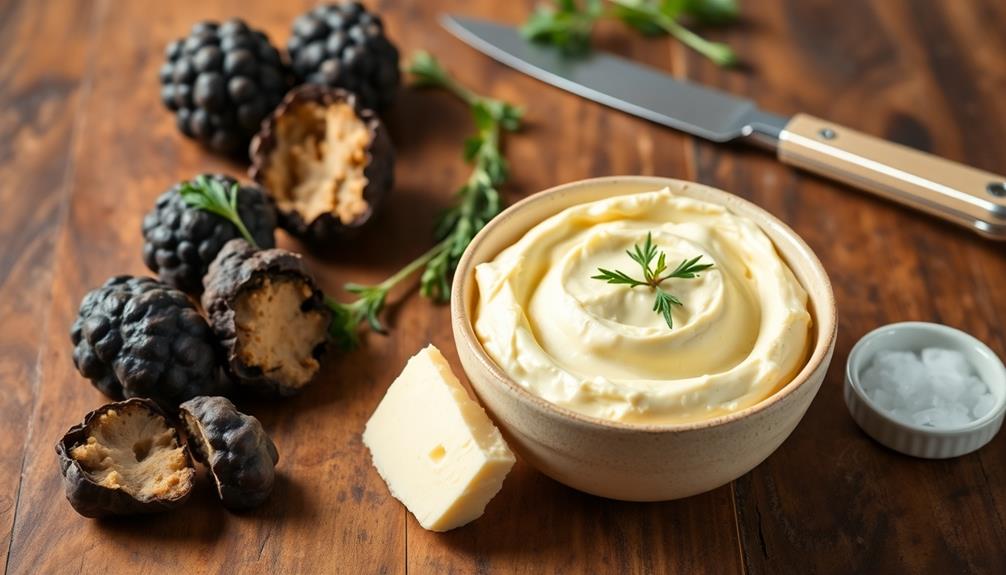
Get ready to whip up your own truffle butter with just a few simple steps. First, you'll need to gather your ingredients: high-quality unsalted butter, fresh truffles, and a pinch of salt. Start by letting the butter soften at room temperature, making it easier to mix in those aromatic truffles.
Next, finely chop your truffles. The amount depends on how strong you want the flavor to be, but a good guideline is about one ounce of truffles for every half cup of butter. Combine the softened butter, chopped truffles, and salt in a bowl. Use a fork or spatula to mix everything until it's well-blended.
Once mixed, transfer your truffle butter onto a sheet of parchment paper. Roll it into a log shape, twist the ends to seal, and refrigerate until firm.
Here's a quick reference table for your truffle butter-making process:
| Step | Action |
|---|---|
| 1. Gather | Butter, truffles, and salt |
| 2. Prepare | Soften butter and chop truffles |
| 3. Mix & Shape | Blend and roll into a log |
Enjoy your homemade truffle butter!
Using Fresh Truffles
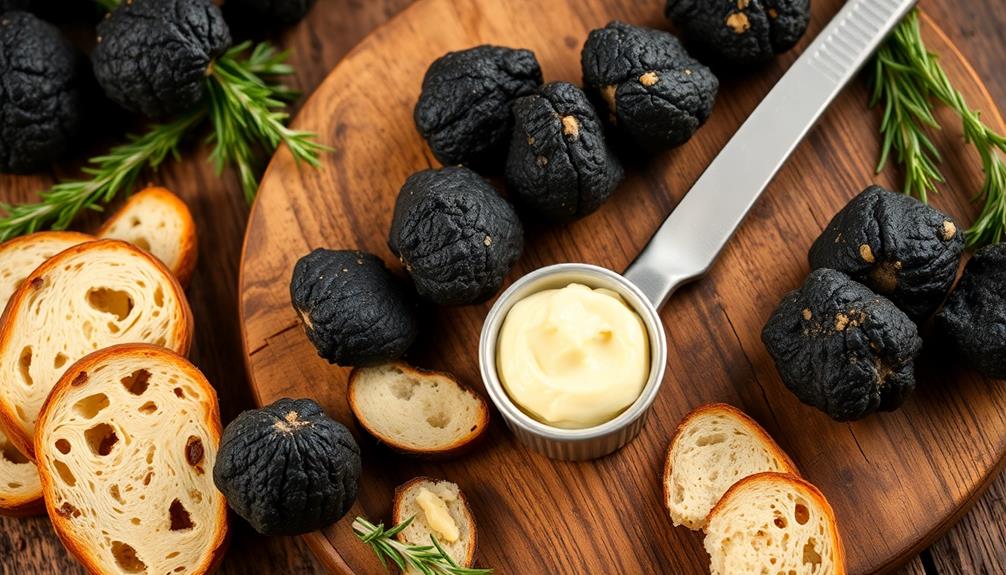
When you're ready to use fresh truffles, start by selecting the best quality ones available.
Their unique flavor can elevate a variety of dishes, so think about how you can incorporate them into your meals.
From simple pasta to gourmet risottos, fresh truffles can transform your cooking experience.
Selecting Fresh Truffles
Selecting fresh truffles requires a keen eye and an appreciation for their unique qualities. When you're on the hunt for these culinary gems, keep a few key factors in mind to guarantee you choose the best ones available.
- Appearance: Look for truffles that have a firm, unblemished surface. The exterior should be rough and warty, indicating freshness. Avoid any with soft spots or excessive dirt.
- Aroma: Fresh truffles have a strong, earthy scent. Give them a gentle sniff; if the aroma is faint or off-putting, they might be past their prime.
- Size: While size isn't everything, larger truffles often offer more intense flavors. However, smaller truffles can be just as flavorful, so don't overlook those.
- Seasonality: Truffle varieties are seasonal, so be aware of when they're typically harvested. For instance, black truffles are usually in season from November to March, while white truffles peak from September to December.
Preparing Truffle Dishes
After choosing the freshest truffles, it's time to bring their exquisite flavors to life in your dishes. Truffles pair beautifully with simple ingredients, so let their unique aroma shine. You can shave them over pasta, risotto, or even scrambled eggs to elevate your meal.
Here are some delicious pairings that'll enhance your truffle dishes:
| Dish Type | Suggested Truffle Use |
|---|---|
| Pasta | Shave fresh truffles on top, enhancing with truffle butter for richness. |
| Risotto | Stir in finely grated truffles just before serving for a luxurious touch. |
| Eggs | Add truffle shavings to scrambled eggs or an omelet for a decadent breakfast. |
When using fresh truffles, it's best to add them just before serving to retain their aroma. Remember, a little goes a long way! Don't overpower your dish; let the truffle's earthiness complement your ingredients. Enjoy experimenting with these pairings, and you'll quickly discover how versatile truffles can be in your kitchen.
Using Truffle Oil

Truffle oil can elevate your dishes with its rich, earthy flavor, making it a versatile ingredient in your kitchen.
You don't need to use it in every recipe; instead, consider it a finishing touch that enhances your culinary creations.
Here are some great ways to use truffle oil:
- Drizzle on Pasta: After tossing your favorite pasta with sauce, add a few drops of truffle oil to amplify the dish's flavor. It's especially delicious with creamy sauces.
- Enhance Risotto: Stir in a teaspoon of truffle oil just before serving your risotto. It adds a luxurious aroma and taste that'll impress any guest.
- Flavor Your Vegetables: Roast vegetables like asparagus or Brussels sprouts, then finish them with truffle oil. The oil brings out their natural sweetness and adds depth.
- Top Your Pizza: After baking your pizza, drizzle a little truffle oil on top. It adds a gourmet touch that elevates even the simplest pies.
Flavor Pairings

When you're using truffle butter, knowing what ingredients complement its rich flavor can elevate your dishes.
Think about pairing it with earthy mushrooms, creamy cheeses, or even seafood for a luxurious twist.
Let's explore the best combinations and ideal dishes that showcase truffle butter's unique profile.
Best Ingredients to Combine
Combining flavors is key to elevating your truffle butter experience, and certain ingredients can enhance its rich, earthy notes beautifully. When you pair truffle butter with the right components, you'll create a symphony of taste that excites the palate.
Here are four fantastic ingredients to contemplate:
- Mushrooms: Their umami flavor complements truffle butter perfectly, making for a decadent combination in risottos or pasta dishes.
- Parmesan cheese: The salty, nutty notes of aged Parmesan elevate the richness of truffle butter, ideal for topping off creamy sauces or polenta.
- Garlic: A touch of roasted garlic adds depth and sweetness, balancing the earthiness of the truffle. Use it in spreads or as a flavor enhancer in sautés.
- Fresh herbs: Herbs like thyme or rosemary can brighten the dish and provide a fresh contrast, enhancing the overall flavor profile without overpowering the truffle notes.
Experimenting with these ingredients won't only make your dishes stand out but also highlight the luxurious qualities of your truffle butter.
Enjoy the process and let your creativity guide your culinary adventures!
Ideal Dishes for Pairing
Elevating your culinary creations with truffle butter opens up a world of delicious possibilities. This luxurious ingredient pairs beautifully with a variety of dishes, enhancing flavors in ways you mightn't have imagined.
Start with pasta—tossing freshly cooked fettuccine in truffle butter adds a rich, earthy depth. You can also use it on risotto, where the creamy texture complements the truffle's umami notes perfectly.
For a simple yet elegant side, sauté vegetables like asparagus or Brussels sprouts in truffle butter; the nutty flavor enhances their natural sweetness.
Don't forget about proteins! Truffle butter makes an excellent finishing touch for steaks, chicken, or even fish, transforming a standard meal into a gourmet experience.
Consider spreading it on toasted bread or mixing it into mashed potatoes for a decadent twist on classic comfort foods.
Storage Tips
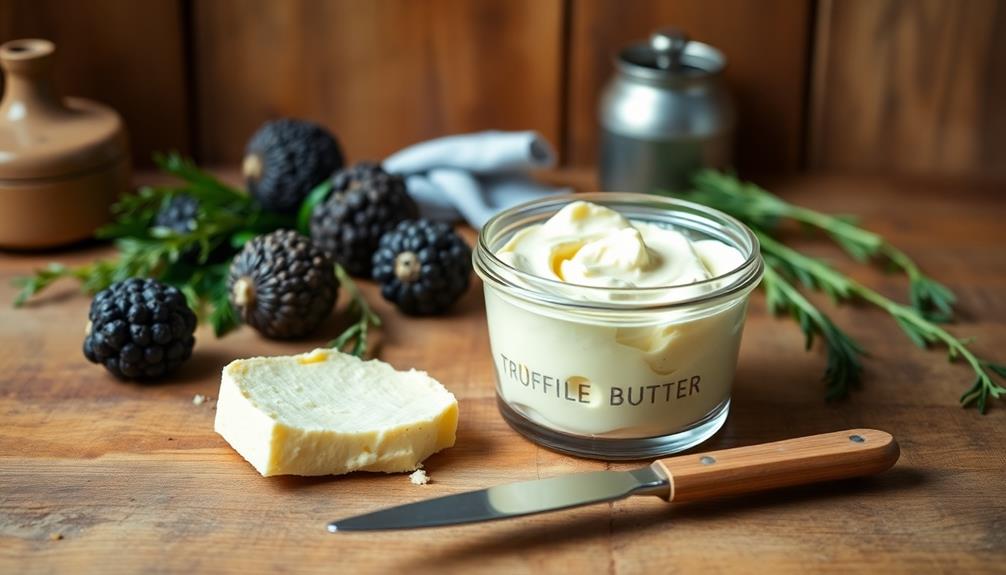
Storing truffle butter properly guarantees you maintain its rich flavor and aromatic qualities. To keep your truffle butter fresh and delicious, follow these essential storage tips:
- Refrigerate Immediately: After making or purchasing truffle butter, place it in the refrigerator right away. The cold temperature helps preserve its flavors and extends its shelf life.
- Use Airtight Containers: Store your truffle butter in airtight containers to prevent exposure to air. This minimizes oxidation and helps maintain its unique aroma.
- Label and Date: Always label your containers with the date of preparation or purchase. This way, you can easily track its freshness and avoid using it past its prime.
- Freeze for Longer Storage: If you want to keep truffle butter for an extended period, consider freezing it.
Portion it into ice cube trays or small containers, then transfer to a freezer bag. This method allows you to use just what you need without thawing the entire batch.
Creative Recipes
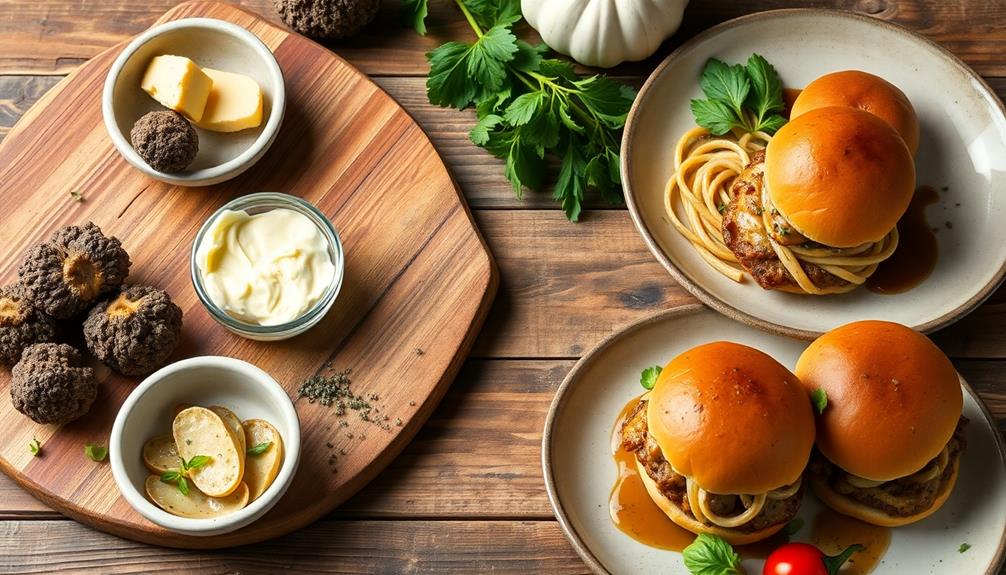
Truffle butter adds an exquisite touch to a variety of dishes, transforming everyday meals into gourmet experiences. One of the simplest ways to use it is by melting a spoonful over perfectly cooked steak or grilled chicken. The rich flavor elevates the meat, making it an instant hit at your dinner table.
Try mixing truffle butter into your mashed potatoes for a luxurious twist on a classic side. The creamy, earthy notes will make your potatoes unforgettable.
You can also stir it into risotto, where its umami flavor enhances the dish beautifully.
For a quick appetizer, spread truffle butter on toasted baguette slices, then top with a slice of fresh mozzarella and a drizzle of balsamic glaze. It's a sophisticated starter that's sure to impress your guests.
If you're looking for a unique pasta dish, toss cooked fettuccine with truffle butter, grated Parmesan, and a sprinkle of black pepper. It's simple yet decadent.
Frequently Asked Questions
Can Truffle Butter Be Frozen for Long-Term Storage?
Yes, you can freeze truffle butter for long-term storage. Just portion it into airtight containers or wrap it tightly in plastic wrap. When you're ready to use it, thaw it in the refrigerator.
Is Truffle Butter Suitable for Vegan Diets?
If truffle butter were a treasure, it'd be one you can't keep if you're vegan. It typically contains butter, which isn't plant-based. So, you'll want to explore alternatives that suit your dietary choices.
How Do I Know if Truffle Butter Is High Quality?
To determine if truffle butter's high quality, check its ingredient list for real truffles, look for a rich aroma, and taste for deep, earthy flavors. Avoid products with artificial additives or overly processed ingredients.
Can I Make Truffle Butter Without Fresh Truffles?
Yes, you can make truffle butter without fresh truffles by using truffle oil or truffle salt. Just mix these with softened butter, adjusting the amount to achieve your desired flavor intensity. It'll still taste fantastic!
What Dishes Pair Best With Truffle Butter?
You'll elevate every dish to gourmet status with truffle butter! It pairs perfectly with pasta, risotto, and meats. Just imagine drizzling it over popcorn or blending it into mashed potatoes for an unforgettable flavor explosion!
Conclusion
Truffle butter is like a secret ingredient that transforms your dishes from ordinary to extraordinary. With just a few simple steps, you can create this luxurious spread and elevate your culinary creations. Whether you're drizzling it over pasta or spreading it on warm bread, its rich flavor will leave your taste buds dancing. So, embrace your inner chef and let truffle butter take your meals on a delicious journey that you won't soon forget.


